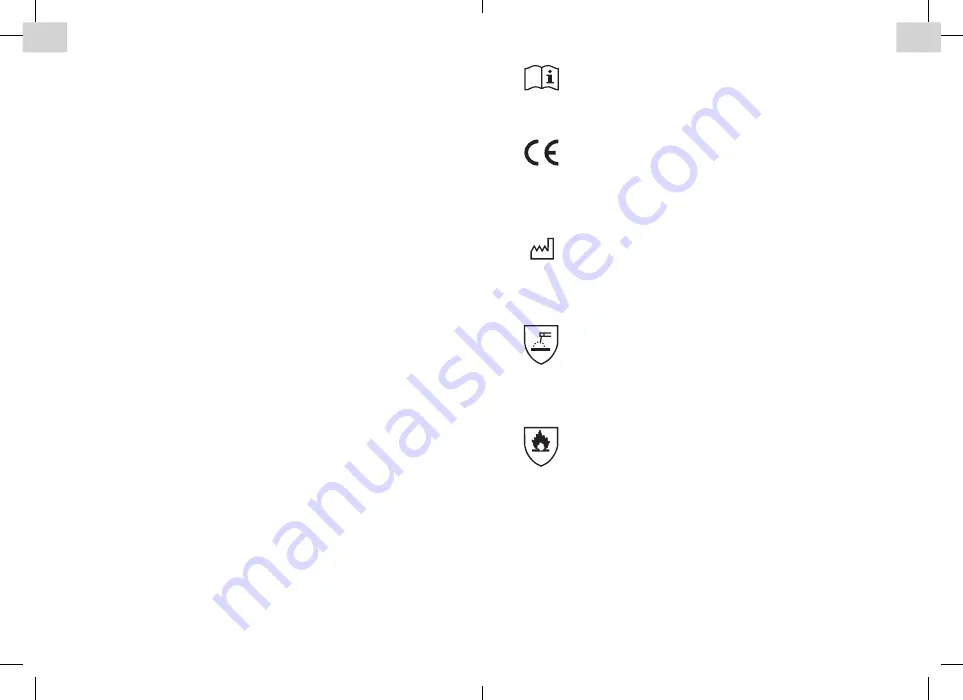
8
9
DE
GB
Pflegehinweis & Alterung:
Die PSA benötigt eine regelmäßige und fachgerechte Pflege. Die Angaben auf dem Pflegeetikett
sind maßgebend für den bestmöglichen Erhalt und die Aufrechterhaltung der Schutzleistung.
Trocknen Sie die Artikel nur im Schatten und lagern Sie ihn an einem lichtgeschützten, trocknen
Ort.
Es ist möglich, dass durch in der Praxis auftretende Abnutzung oder Beschädigung die Lebens-
dauer der Kleidung deutlich reduziert werden kann. Auch Verunreinigungen durch Schmutz, Näs-
se, Schweiß oder Ausbleichung durch Sonnenlicht kann die Lebensdauer der PSA verringern.
Mögliche Alterungsfaktoren sind u.a.:
– Reinigung, Instandhaltungs- oder Desinfektionsprozesse
– Einwirkung von hohen oder niedrigen Temperaturen oder Temperaturwechseln
– Einwirkung von Chemikalien einschließlich Feuchtigkeit
– Mechanische Einwirkungen (Abrieb, Biegebeanspruchung, Druck- und Zugbeanspruchung)
– Kontamination z. B. durch Schmutz, Öl, Spritzer geschmolzenen Metalls usw.
– Abnutzung
Pflegehinweis: Die Bekleidung muss regelmäßig nach jeder Wäsche nachimprägniert werden.
Um den Chemikalienschutz EN 13034 Typ 6 in Verbindung mit den flammhemmenden Eigen-
schaften der PSA aufrecht zu erhalten, empfehlen wir das hierfür geprüfte Imprägniermittel der
Fa. Kreussler (Hydrob FC). Das Imprägniermittel darf die anderen Schutzfunktionen nicht be-
einträchtigen.
Prüfen Sie nach jedem Wasch- und Trocknungsvorgang, ob das Textil Risse aufweist, oder Gum-
mizüge spröde werden. Beides sind Anzeichen dafür, dass die Schutzwirkung des Textils nicht
mehr gewährleistet werden kann. Reparaturen dürfen nur von kompetenten Firmen durchgeführt
werden.
Verwendungsgrenzen & Risikoanalyse:
– Die PSA ist für die unter üblichen Schweißbedingungen entstehenden Gefahren, sowie
den weiten Bereich von Endanwendungen mit kurzzeitigem Kontakt von Flammen und
Strahlungs-, konvektiver und Kontaktwärme vorgesehen.
– Die Bekleidung hat keine elektrisch isolierende Schutzwirkung und ist nicht für Arbeiten an
Leitungen mit großen elektrischen Strömen geeignet.
– Die begrenzte Flammausbreitung geht verloren, wenn die Schutzkleidung mit entzündlichen
oder hochentzündlichen Stoffen, wie z.B.: Ölen, Benzin u. ä. verunreinigt wird
– Für angemessenen umfassenden Schutz sollte zusätzlich PSA für Kopf, Gesicht, Hände und
Füße getragen werden.
– Eigenmächtige Veränderungen sind aus Sicherheitsgründen nicht gestattet.
–
Es besteht das Risiko von Verbrennungen, Verätzungen oder Stromschlägen,
sofern die Kleidung beschädigt oder verschmutzt ist, nicht richtig getragen wird, oder die
Sicherheitshinweise nicht beachtet werden.
–
Des Weiteren besteht dieses Risiko von irreversiblen Schäden, wenn die
Einwirkung der Gefährdung die geprüften Werte oder die geprüfte Dauer übersteigen und in
Kombination auftreten.
The protective clothing fulfils the basic health & safety requirements of Annex II
of Directive (EU) 2016/425 and EN 13688:2013 Protective clothing.
General requirements:
The information in this brochure about the use of the protective clothing must be ob-
served at all times.
CE label: An external sign indicating that a product satisfies the requirements
of the European Union made of the manufacturer.
The declaration of conformity can be found at the following link:
www.engelbert-strauss.com/declaration-of-conformity
Explanation of the symbols:
The production date describes the time of production in pictures and texts on the PO label in the
item.
The factory symbol indicates the place of production, and the numbers indicate
the month and year in which the item was produced.
Ensure that the clothing fits (width + length). Clothing that is too wide or too tight can impact on
the protective effect.
This protective clothing also satisfies the requirements of the:
1) Welder‘s protective clothing acc. to EN ISO 11611:2015
Protects the wearer against small metal splashes, brief contact with flames and
UV rays. Additional physical protection may be required during extreme welding
or flexing. Classification in:
Class 1: offers protection against less dangerous welding procedures and
workplace situations with few welding splashes and low radiation heat
Class 2: offers protection against more dangerous welding procedures and
workplace situations with more welding splashes and higher radiation heat
Identification A: A1 and/or A2 (Type of flame test)
2) Protective clothing for workers exposed to heat acc. to EN ISO 11612:2015
Protects specific parts of the bodies of workers exposed to heat from brief contact
with flames, thermal radiation and hot iron splashes or a combination of these risks.
Code A: Limited flame spread (Code A1 or A2)
Code B: Convective heat (1 low to 3 high)
Code C: Radiation heat (1 low to 4 high)
Code D: Liquid aluminium splashes (1 low to 3 high)
Code E: Liquid iron splashes (1 low to 3 high)
Code F: Contact heat (1 low to 3 high)
The wearer should immediately withdraw and carefully remove any garments
that have become soiled with random splashes of liquid chemicals or flammable
fluids; he must ensure that these do not come into contact with his skin. Then the
clothing needs to be cleaned or disposed of. In the event that the clothing is soiled
with splashes of molten metal, the wearer must immediately leave the workplace
and remove the garments. A risk of burns cannot be ruled out if the garment is
worn next to the skin.
MM/JJJJ
Summary of Contents for 63.64.1
Page 46: ......
Page 47: ...ESBO0015 V3 ...




















